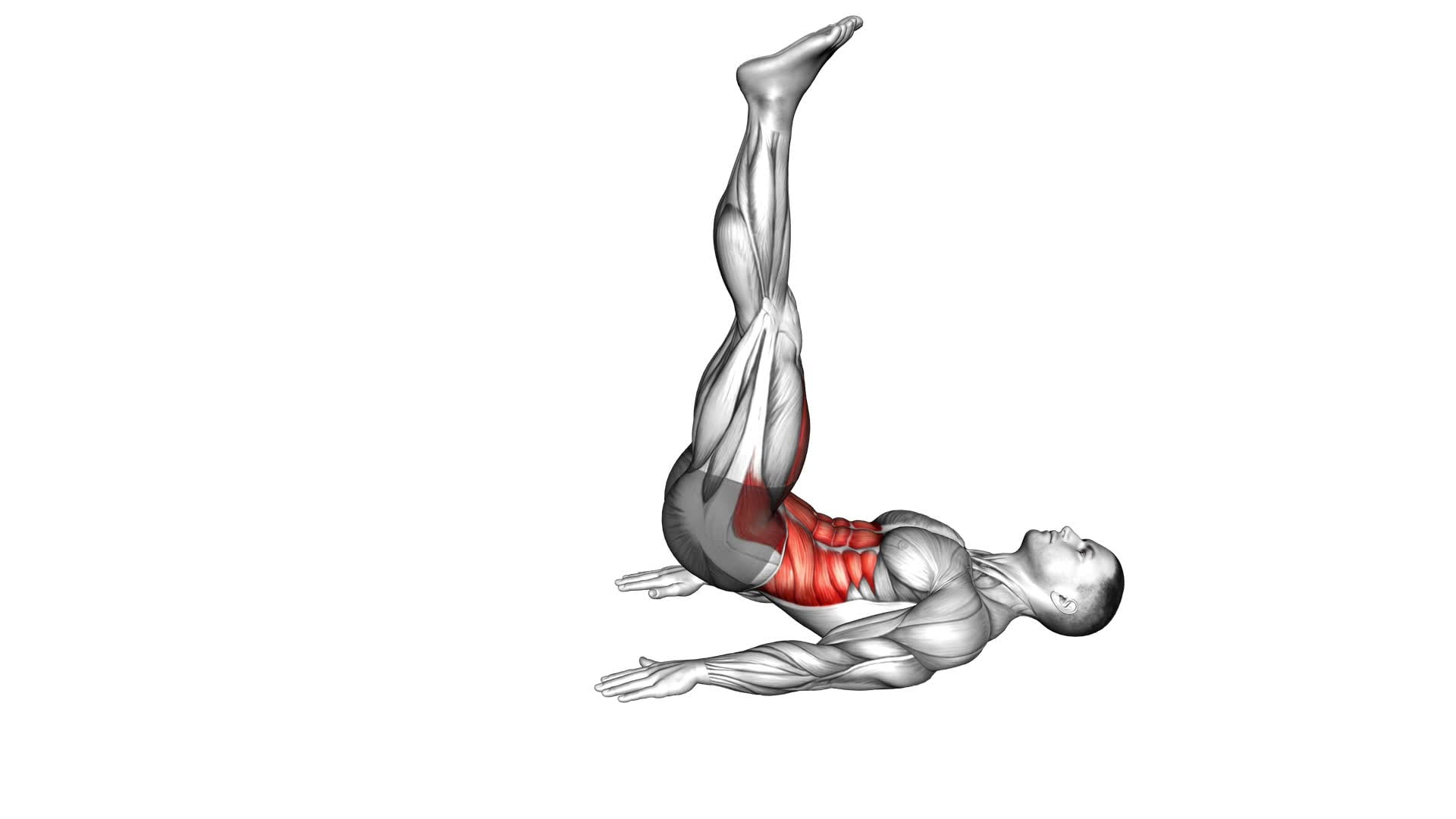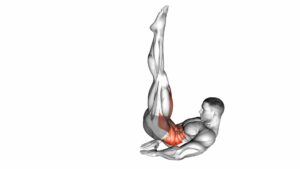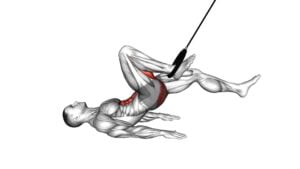Leg Raise Hip Lift (male) – Video Exercise Guide & Tips

Are you looking for an effective way to strengthen your core and tone your lower body? Look no further than the Leg Raise Hip Lift.
Watch This Exercise Video
This exercise targets your abs, hips, and glutes, giving you a toned and sculpted physique.
In this video exercise guide, we'll show you the proper form and technique, variations to challenge yourself, common mistakes to avoid, and tips for beginners.
Get ready to take your fitness routine to the next level with the Leg Raise Hip Lift.
Key Takeaways
- The Leg Raise Hip Lift exercise strengthens core muscles, enhances stability and balance, and improves hip mobility and flexibility.
- It targets lower abdominal muscles, hip flexors, and glutes, while also building core strength and stability.
- Proper form and technique include keeping the back flat on the ground, controlling the movement with hip flexors, and engaging the core throughout.
- Common mistakes to avoid include lifting the legs too high, relying on momentum instead of core muscles, and arching the back.
Benefits of the Leg Raise Hip Lift
The leg raise hip lift exercise offers numerous benefits for men. By incorporating this exercise into your workout routine, you can improve your core strength and increase hip mobility.
Firstly, let's talk about core strength. The leg raise hip lift primarily targets your abdominal muscles, including the rectus abdominis and obliques. As you lift your legs off the ground, you engage your core to stabilize your body and maintain proper form. This exercise helps to strengthen your core muscles, which not only enhances your overall stability but also improves your posture and balance.
Secondly, the leg raise hip lift also helps to increase hip mobility. By lifting your legs towards the ceiling, you actively engage your hip flexors. This movement helps to stretch and strengthen the muscles in your hips, allowing for better flexibility and range of motion. Increased hip mobility can be beneficial for various activities, such as running, squatting, and even everyday movements like bending down or sitting.
Proper Form and Technique
To perform the leg raise hip lift exercise with proper form and technique, maintain a strong core and engage your hip flexors throughout the movement. This will ensure maximum effectiveness and prevent injury. Here are some tips to help you perfect your form:
- Keep your back flat on the ground: This will help you engage your core and prevent any strain on your lower back.
- Control the movement: Avoid using momentum or swinging your legs. Instead, focus on lifting your legs using your hip flexors and lower them back down in a slow and controlled manner.
- Maintain a slight bend in your knees: This will help you target your hip flexors more effectively.
- Avoid lifting your legs too high: Lifting your legs beyond a 90-degree angle can strain your lower back. Aim to lift them just high enough to engage your hip flexors.
Now let's address some common misconceptions and advanced modifications:
Common misconceptions:
- Many people think that lifting the legs as high as possible will yield better results, but this can lead to improper form and strain on the lower back.
- Others believe that the leg raise hip lift exercise only targets the lower abs, but it actually engages multiple muscles including the hip flexors, lower abs, and obliques.
Advanced modifications:
- To increase the challenge, you can add ankle weights or hold a medicine ball between your feet while performing the exercise.
- Another advanced modification is to perform the exercise on a decline bench, which increases the range of motion and engages the muscles to a greater extent.
Variations to Challenge Yourself
Explore different variations of the leg raise hip lift exercise to challenge yourself and target specific muscle groups. If you're looking to take your workout to the next level, try incorporating advanced modifications to intensify the exercise and increase muscle activation.
One variation you can try is the weighted leg raise hip lift. This involves holding a dumbbell or a weighted plate between your feet while performing the exercise. The added resistance won't only challenge your core muscles but also engage your hip flexors and lower abdominals to a greater extent.
Another variation is the single-leg leg raise hip lift. Instead of raising both legs simultaneously, you can lift one leg at a time while keeping the other leg extended and hovering just above the ground. This variation not only increases the difficulty of the exercise but also helps to improve balance and stability.
To further challenge yourself, you can also experiment with different tempos and ranges of motion. Slowly lowering your legs and pausing at the bottom before lifting them back up can increase the time under tension, making the exercise more challenging and effective.
By incorporating these advanced modifications, you can maximize the muscle activation and take your leg raise hip lift exercise to new heights.
Now, let's move on to the next section and learn about the common mistakes to avoid for optimal results.
Common Mistakes to Avoid
Avoid these common mistakes to ensure proper form and maximize the effectiveness of the leg raise hip lift exercise.
Proper form is crucial in order to target the correct muscles and prevent injury. Here are some common mistakes to watch out for:
- Using momentum: One common mistake is using momentum to lift your legs instead of relying on your core muscles. This not only reduces the effectiveness of the exercise but also puts unnecessary strain on your lower back. Make sure to engage your core and lift your legs using controlled movements.
- Arching your back: Another mistake is arching your back during the exercise. This can happen when your core muscles aren't engaged properly. To avoid this, focus on keeping your back flat against the ground throughout the movement. This will help target your abdominal muscles and protect your lower back.
Remember to pay attention to your form and make adjustments as needed. By avoiding these common mistakes, you'll be able to perform the leg raise hip lift exercise correctly and get the most out of your workout.
Now that you know the common mistakes to avoid, let's move on to some tips for beginners to help you get started with the leg raise hip lift exercise.
Tips for Beginners
Now let's focus on some helpful tips for beginners to effectively perform the leg raise hip lift exercise.
If you're new to this exercise, it's important to start with beginner modifications to ensure proper form and avoid injury. Begin by lying on your back with your legs extended and your hands placed by your sides.
Instead of lifting both legs at once, you can start by lifting one leg at a time, gradually progressing to lifting both legs together as you gain strength and stability. This modification allows you to focus on engaging your core and hip muscles without overwhelming them.
As you become more comfortable with the exercise, you can incorporate progressions for advanced users. One option is to add ankle weights or resistance bands to increase the intensity of the exercise. Another progression is to perform the leg raise hip lift exercise on an incline bench, which increases the challenge for your abdominal muscles.
By incorporating these modifications and progressions, you can gradually improve your strength and stability, setting a solid foundation for more advanced exercises.
Now, let's explore how to incorporate the leg raise hip lift into your workout routine.
Incorporating the Leg Raise Hip Lift Into Your Workout Routine
To incorporate the leg raise hip lift into your workout routine, you can gradually increase the difficulty by adding variations and challenges. This won't only keep your routine interesting but also help you make progress and achieve your fitness goals. Here are some ways you can do this:
- Increase the number of repetitions: Start with a comfortable number of leg raise hip lifts and gradually increase the repetitions as you get stronger. This will challenge your muscles and improve their endurance.
- Add ankle weights: To make the exercise more challenging and increase resistance, you can wear ankle weights while performing the leg raise hip lift. This will engage your muscles even more and enhance the effectiveness of the exercise.
By incorporating these variations and challenges into your leg raise hip lift routine, you can take full advantage of the exercise's benefits. The leg raise hip lift targets the lower abdominal muscles, hip flexors, and glutes, helping to strengthen and tone these areas. It also improves core stability and balance.
The exercise is highly effective in building core strength and stability, which is essential for proper posture and overall functional fitness. So, don't be afraid to push yourself and try different variations to maximize the effectiveness of the leg raise hip lift in your workout routine.
Frequently Asked Questions
How Many Calories Can I Burn by Doing the Leg Raise Hip Lift Exercise?
You can burn a significant amount of calories by doing the leg raise hip lift exercise. This exercise targets your lower abs, hip flexors, and glutes, helping you tone and strengthen those areas.
The number of calories burned depends on factors like your weight, intensity, and duration of the exercise. Additionally, there are different variations of the leg raise hip lift exercise that can increase the calorie burn, such as adding weights or performing the exercise on an incline.
Can the Leg Raise Hip Lift Help Improve My Lower Back Flexibility?
The leg raise hip lift can definitely help improve your lower back flexibility. By engaging your core muscles and targeting your hamstrings, this exercise stretches and strengthens the muscles in your lower back.
It also increases mobility and range of motion in your hips, which can contribute to improved flexibility. Additionally, the leg raise hip lift offers great benefits for core strength, as it requires stabilizing your body while performing the movement.
Can I Perform the Leg Raise Hip Lift Exercise Without Any Equipment?
Yes, you can perform the leg raise hip lift exercise without any equipment. This exercise is great for improving core strength and targeting your lower abs. By lying flat on your back and raising your legs while lifting your hips off the ground, you engage your abdominal muscles.
You can also try variations of the leg raise hip lift, such as adding ankle weights or performing the exercise on an incline bench for an extra challenge.
Is It Safe to Do the Leg Raise Hip Lift Exercise if I Have a History of Lower Back Pain?
If you have a history of lower back pain, it's important to be cautious when doing the leg raise hip lift exercise. It may not be safe for you to perform it without modifications.
Instead, consider alternative exercises that are gentler on your lower back, such as knee tucks or pelvic tilts. These exercises can help strengthen your core and improve stability without putting excessive strain on your lower back.
Always consult with a healthcare professional for personalized advice.
Can the Leg Raise Hip Lift Exercise Help Me Improve My Posture?
Yes, the leg raise hip lift exercise can help you improve your posture by providing several benefits.
By engaging your core muscles and lower back, this exercise strengthens your back and abdominal muscles, which play a crucial role in maintaining proper spinal alignment.
Additionally, the leg raise hip lift exercise targets the muscles in your hips and glutes, helping to correct imbalances and promote better posture.
Regular practice of this exercise can lead to improved posture and a healthier spine.
Conclusion
Incorporating the leg raise hip lift into your workout routine can provide numerous benefits. This exercise is great for strengthening your core muscles and improving your hip mobility. By following proper form and technique, you can ensure that you are getting the most out of this exercise. It's also important to challenge yourself with variations of the leg raise hip lift to continue progressing and avoid plateauing. Additionally, being aware of common mistakes and avoiding them will help prevent injury and make the exercise more effective. Whether you're a beginner or more experienced, the leg raise hip lift can be modified to suit your fitness level. So why not give it a try and take your fitness to the next level?

Author
Years ago, the spark of my life’s passion ignited in my mind the moment I stepped into the local gym for the first time. The inaugural bead of perspiration, the initial endeavor, the very first surge of endorphins, and a sense of pride that washed over me post-workout marked the beginning of my deep-seated interest in strength sports, fitness, and sports nutrition. This very curiosity blossomed rapidly into a profound fascination, propelling me to earn a Master’s degree in Physical Education from the Academy of Physical Education in Krakow, followed by a Sports Manager diploma from the Jagiellonian University. My journey of growth led me to gain more specialized qualifications, such as being a certified personal trainer with a focus on sports dietetics, a lifeguard, and an instructor for wellness and corrective gymnastics. Theoretical knowledge paired seamlessly with practical experience, reinforcing my belief that the transformation of individuals under my guidance was also a reflection of my personal growth. This belief holds true even today. Each day, I strive to push the boundaries and explore new realms. These realms gently elevate me to greater heights. The unique combination of passion for my field and the continuous quest for growth fuels my drive to break new ground.







